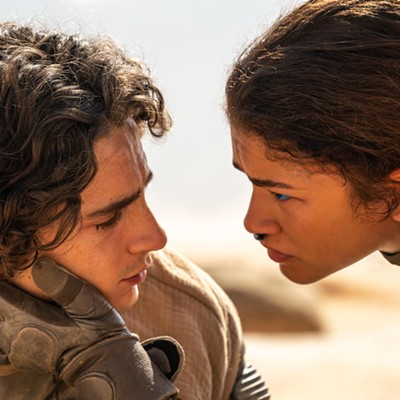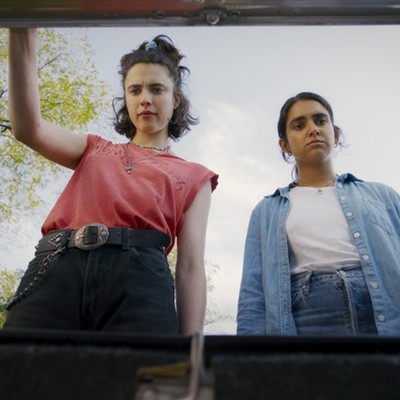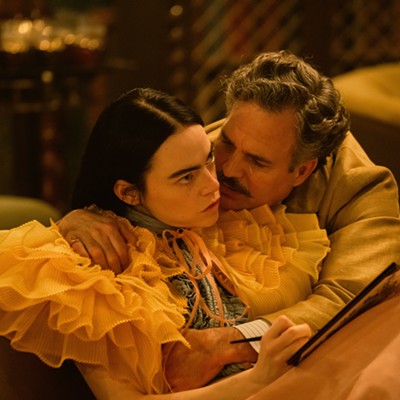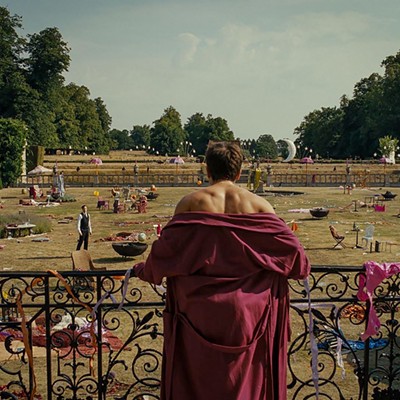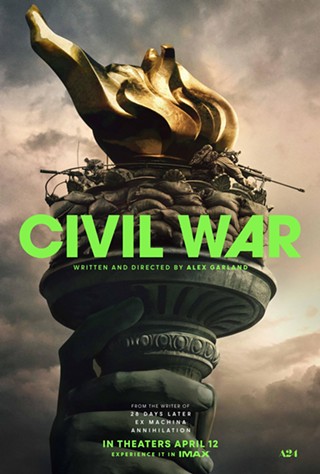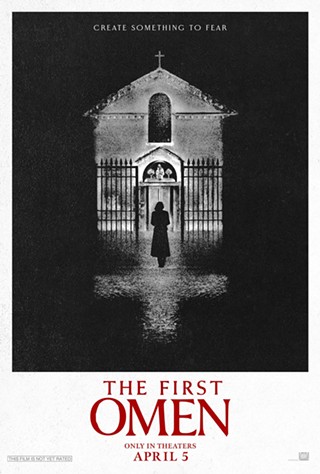Many have tried to capture the West on canvas, through verse, in song and on paper. This spring, some of its most eloquent moments on film will get a rare homage in American Place in American Avant-Garde Film, a free series continuing Mondays through April 25 on the UA campus.
The series is the brainchild of visiting media arts professor Dr. Scott MacDonald, a central New Yorker who is himself something of a mystified traveler in a foreign land. He's been grappling with the concept of place for the last decade, and it's the subject of his seventh book on avant-garde cinema, entitled The Garden in the Machine.
"(The title) is a take-off on Leo Marx's famous book The Machine in the Garden, about the arrival of the locomotive to the American Eden of the 19th century. He talks about trying to come to terms with the industrial revolution, and what you would rather think of as a kind of dying, natural space.
"My premise is that a century later, as Americans, we're dealing with basically the same issue. But now the whole country is a continental machine, and what we're looking for are the little moments of garden -- not just physical garden, but what a garden means -- in that machine."
To that end, MacDonald started his series in early February with films that examined the city, and cityscapes. This month, the series switches focus to a broad understanding of landscape, with five filmmakers with vastly different takes on filming nature.
Working almost entirely alone, with territory as sprawling as Interstate-10 to specific as an Iowa City backyard, they capture with stunning camera work and multi-media mastery both the timelessness of wilderness and the spectacle of American drive-thru culture at its most shameless.
Accessibility is an underlying issue not only to the filmmakers, but for curator MacDonald as well. His series is aimed at those who may have previously assumed avant-garde is French for "I don't get it."
"I've never liked the term avant-garde," he says. "It sounds like the avant-garde gets there first, and then everybody else follows. That's true sometimes, but just as often Hollywood gets there first, and then the avant-garde satirizes it."
Though incredibly knowledgeable (a three-volume anthology he authored was distinguished last year as "a landmark in film preservation"), MacDonald is a down-to-earth speaker, motivated not by academic egoism but rather a genuine love of cinema. "I love all kinds of film," he says. "I think there are four great histories of film. There's commercial filmmaking, there's documentary, there's animation and there's this stuff. This is the most endangered."
Through his relationships with filmmakers and cooperative distributors who archive these rare prints, MacDonald has assembled quite a collection for the state-of-the-art screening room in the UA Aerospace and Mechanical Engineering auditorium at Mountain Avenue and Speedway Boulevard. "Because of the way avant-garde exhibition works these days," he laments, "this is the only opportunity to see these films in Tucson. The problem with saying it that way is people might think they're not worth seeing. That's not true, though. Some of the greatest art in the world is at Munich Gallery, but you have to go there to see it. It's not going to come to you. That's how I look at these films."
It's a problem endemic to a medium dominated by commercial and independent film. "No matter how good (avant-garde) cinema is, it doesn't get in front of audiences. Consequently, it doesn't get rented much, so prints aren't struck...so it's a little bit like nature itself. It's endangered."
Last Monday's screening of The Sky on Location, what MacDonald calls a seminal landscape film by Parisian-born filmmaker Babette Mangolte, certainly lends credence to that theory. As he does before each film in the series, at a private screening MacDonald gives an abbreviated context: Mangolte, a still photographer and cinematographer, sets out to capture what it might have felt like for European settlers to gaze on the West for the first time.
The color images of her 16 mm feature have the feel of photographs, still images except for the subtle movement of grass, water, wind, clouds and shadow. The only sound is weather, offset by a collage of narrative voice-overs from the filmmaker and "a chorus of deliberately annoying New York voices" offering history and commentary on the relationship between humans and nature. Watching her footage of National Parks, most notably in Montana, Idaho, Wyoming and Colorado, offers a glimpse of the West increasingly difficult to experience in life: that of a place uninhabited by humans.
"This is part of the premise, too, that when you go into a movie theater you're inside a machine. There's a machine in a room, and you turn out these machines (lights) and you turn on that machine (projector) and sound is going on. You're in an electronic, mechanical space, looking at a natural thing. And yet, seeing nature in a movie theater can re-alert you to reality."
The next film in the series dons the cloak of subjective reality and western myth with Roam Sweet Home, a 56-minute, E-ticket Airstream ride by New York filmmaker Ellen Spiro...as anthropomorphically narrated by her dog Sam. Hers is the only work on video, but there is nothing two-dimensional about this charming and often profound exploration of RV counter-culture, mortality and escapism. What Spiro delivers is a deeply human work that has both a sense of humor and an eye for the hidden beauty of garish and unwashed Americana. It's a great use of funding from the NEA and Corporation for Public Broadcasting, challenging as it does the notion that video is film's ugly step-sibling. It's a medium perfectly suited to her transitory subject matter. But Spiro will best speak for herself at the Wednesday, March 29, screening, where she'll introduce and discuss her work.
The series takes a sharp turn from narrative to experimental on April 3. The theme for that night is "Transcendental Domesticity," a term MacDonald explains with a grin. "When Leighton Pierce became a father, he became a great filmmaker. He questions, 'Does my artwork have to be separate from my life?' Most men artists, of course, have said 'Yes.' Most women artists didn't have that luxury. But starting about 1991, Pierce started to re-see his home, transforming certain everyday details into this mythic mysteriousness."
In Fifty Feet of String, one of the rules is he can't film anything beyond 100 feet from his kitchen; and in Wood, his boundary is the back yard where each frame is a moving composition of saturated color, form and sound, moving from one to the next like a slide presentation. Its blurred edges, ethereal shapes and stunning sound give it a dreamy, meditative quality that makes its mundane subjects -- water pooling on a picnic table, a hand sawing a branch, the flight of an empty swing set -- mesmerizing.
It's as much about sound as image. "He studied to be a sound artist at the Boston Philharmonic," MacDonald explains, "and then really got into film and videos to have something to look at while you're listening to these complicated sounds."
Continuing the experimental bent on April 10 is Pat O'Neill's Water and Power, another feature-length work that takes an interpretive turn on Los Angeles' dark history. Like the fictional Chinatown and the documentary Mulholland's Dream (part of PBS' "Cadillac Desert" series a few years back), Water and Power addresses, in a fashion, Los Angeleans' usurpation of land and water from the Owens Valley to ensure their survival in an increasingly waterless desert basin 200 miles away.
"O'Neill in a way uses L.A. to reinvent the city film," says MacDonald. "Because for O'Neill, to pretend that country and city are separate is absurd. L.A. only exists by draining Owens Valley. He's this great optical printer guy, so you're simultaneously seeing L.A. and Owens Valley."
Water and Power, like the city it follows, is a complex layering of disjointed and incongruent elements. Stock footage of black-and-white Hollywood movies, lots of time lapse photography, computer animation and ghostly x-ray images alternately move slowly across the horizontal screen, and frenetically within each frame. Sound ranges from noir movie dialogue to an experimental jazz score, to a silent narrative of subtitles against a black screen.
Images of Mono Lake, Owens Valley, the towering steel aqueduct and modern metropolis move through each other, background to foreground and back again.
If you try too hard to figure out where you're going, it's bound to overwhelm. But if you simply sit back and let it wash over you, letting its kaleidoscopic images run their course, it's brilliant.
"To me, Water and Power is kind of what you hear people saying about Tucson: It's fantastic, but we're killing it. At the same time we love it, it's being destroyed. That's kind of the mood, I think, of Water and Power."
It certainly is unlike anything else you'll see in theaters this year.
"That's what I want people to come away with," MacDonald says. "There's this whole history of other kinds of film, this whole other film world. This is about landscape and cityscape, but we could do 50 series about 50 different subjects. I love commercial film, too. But if I were only watching commercial film, that would be a tremendous loss. It would be like if you were teaching literature and you never knew there was poetry, or never knew the short story was a form."
American Place in American Avant-Garde Film continues through April 25 in the UA Aerospace and Mechanical Engineering Auditorium, northeast corner of Speedway Boulevard and Mountain Avenue. All screenings start at 6:30 p.m., and admission is free. For more information, call 621-7352.
"Roam Sweet Home" screens on Wednesday, March 29. "Transcendental Domesticity," short works by Leighton Pierce, screens on Monday, April 3; and "Water and Power," by Pat O'Neill, screens on Monday, April 10.
The series concludes with "The West According to James Benning," a five-part series Wednesdays and Mondays, April 12, 17, 19 and 24. Filmmaker Benning will attend the final screenings on Monday and Tuesday, April 24 and 25.

